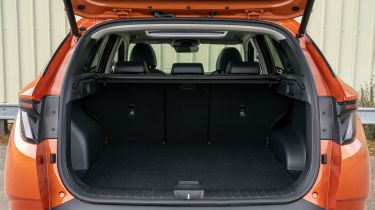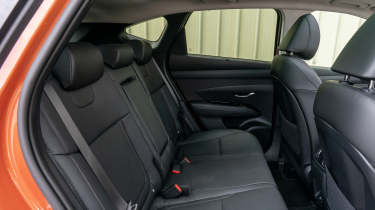Hyundai Tucson - Boot space, comfort & practicality
A decent boot, plenty of passenger room, and useful practical touches mean the Hyundai Tucson fits seamlessly into family life

Passengers won’t be disappointed with the amount of interior space offered in the Hyundai Tucson. The driver’s seat and steering wheel have plenty of adjustment for rake and reach.
Hyundai has added a lot of features, even to entry-level cars, to make the Tucson a truly versatile family SUV. The rear seats fold in a 40:20:40 configuration, while there are front and rear armrests with cupholders and extra storage for assorted oddments. You’ll also find useful USB ports front and back, along with standard parking sensors and a rearview camera.
If you want to pay for it, higher trim levels have luxuries such as an electrically operated tailgate, three-zone climate control and heated and ventilated seats to make longer journeys that bit more comfortable.
|
Dimensions | |
|
Length |
4,500mm |
|
Width |
1,865mm |
|
Height |
1,653mm |
|
Number of seats |
5 |
|
Boot space |
620-1,799 litres (577-1,651-litres Hybrid & Plug-in Hybrid) |
Dimensions and size
The Hyundai Tucson measures 4,500mm in length, 1,865mm wide (excluding door mirrors), and 1,653mm tall. As a comparison, the Volkswagen Tiguan is longer at 4,539mm, although the Tucson is 23mm wider.
Seats, leg room, head room & passenger space
The latest Tucson’s wheelbase is only marginally longer than the previous model’s, but Hyundai has been clever with the car’s packaging to ensure that the cabin can easily accommodate four six-footers, with plenty of knee, leg and headroom. There is space for a third rear passenger, but the raised central floor prevents them from finding a truly comfortable position. The seats themselves are supportive, and there’s plenty of space under the front seats for rear passengers’ feet.
Boot Space
The Hyundai Tucson offers 620-litres boot space in petrol manual form with the seats up, expanding to 1,799-litres with the seats down, which makes it family-friendly. That's around 30 litres more than you get in a Kia Sportage and a whopping 116-litres more than the Nissan Qashqai can manage.
However, it’s worth noting that both hybrid and plug-in hybrid Tucson models have a reduced boot capacity of 577-litres with the seats up, and 1,651-litres with the seats folded, although that’s still much better than a plug-in eHybrid Volkswagen Tiguan, which only has 490 and 1,486 litres of capacity respectively.
We think a few more hooks and individual storage compartments would be helpful, but overall, the space and flat floor should be fine for most day-to-day needs. The Tucson also has a modest amount of under-floor boot storage, which is always handy.
Towing
Both the manual and automatic petrol Hyundai Tucson models have a maximum braked towing weight of 1,510kg, while the hybrid drops down to 1,360kg. The plug-in hybrid is the least capable tow vehicle, and can only manage 1,210kg.
If you need to tow more, then the facelifted Ford Kuga has a much more impressive 1,600kg towing figure for the front-wheel drive hybrid, 1,730kg for the entry-level petrol manual, and a whopping 2,100kg for the plug-in hybrid and four-wheel drive hybrid cars.









